-
For 2024 Pilgrims: €50,- donation = 1 year with no ads on the forum + 90% off any 2024 Guide. More here.
(Discount code sent to you by Private Message after your donation)
Search 69,459 Camino Questions
You are using an out of date browser. It may not display this or other websites correctly.
You should upgrade or use an alternative browser.
You should upgrade or use an alternative browser.
Pole: About caring poles
- Thread starter WldWil
- Start date
Ideal sleeping bag liner whether we want to add a thermal plus to our bag, or if we want to use it alone to sleep in shelters or hostels. Thanks to its mummy shape, it adapts perfectly to our body.
€46,-
€46,-
Mike Savage
So many friends to meet . . . so little time
- Time of past OR future Camino
- Camino Francés,Inglés
Muxia/Finisterre
Português Coastal
Português Central
Sanabrés
Good question. I have never used poles but have always had pain in my knees when backpacking or hiking downhill. If I only use them for downhill and they give some relief then the will be a Godsend and I will gladly carry the weight.
- Time of past OR future Camino
- Camino Frances (2013)
On the Camino I used my poles only on the downhills, until I developed tendinitis in my lower shin; then I used them 100% of the time. When I go Camino again, I will use them 100% of the time - they provide a great upper body workout.
Get a spanish phone number with Airalo. eSim, so no physical SIM card. Easy to use app to add more funds if needed.
- Time of past OR future Camino
- See signature.
I usually put my poles in the pack when I'm walking around a big city, but other than that I use them. I agree with Icacos about the upper body workout, but I do it mainly to protect my knees.
- Time of past OR future Camino
- 2006 to date: Over 21 Caminos. See signature line
I wasn't quite sure how to answer the poll, but I use my poles mainly on the downhills.
Otherwise, they're probably in (or on) my pack.
Otherwise, they're probably in (or on) my pack.
- Time of past OR future Camino
- Camino Frances (2013)
I agree with you completely about using poles to protect one's knees; the upper body workout is an added bonus.I usually put my poles in the pack when I'm walking around a big city, but other than that I use them. I agree with Icacos about the upper body workout, but I do it mainly to protect my knees.
Very light, comfortable and compressible poncho. Specially designed for protection against water for any activity.
Our Atmospheric H30 poncho offers lightness and waterproofness. Easily compressible and made with our Waterproof fabric, its heat-sealed interior seams guarantee its waterproofness. Includes carrying bag.
€60,-
Our Atmospheric H30 poncho offers lightness and waterproofness. Easily compressible and made with our Waterproof fabric, its heat-sealed interior seams guarantee its waterproofness. Includes carrying bag.
€60,-
CarlaH
Member
- Time of past OR future Camino
- SJPP to Santiago 2014
SJPdP to Santiago 2015
Via Francigena (Italy: Aosta - Rome)2016
Camino Portuguese from Porto 2016
The only time my poles aren't in use is when I enter a building... they are in use for every step I take in pre Camino training and on the Camino itself, they're great 'support' for my bodgy knees
SYates
Camino Fossil AD 1999, now living in Santiago de C
- Time of past OR future Camino
- First: Camino Francés 1999
...
Last: Santiago - Muxia 2019
Now: http://egeria.house/
Took my pole out the second day, first was on flat ground, and didn't put it back until I arrived in Santiago nearly 6 months later. SY
- Time of past OR future Camino
- Past: a few
Last: Sanabres
Next: St Olav's Way
I cannot match six months. But I use them pretty much continually on my longer walks.
St James' Way - Self-guided 4-7 day Walking Packages, Reading to Southampton, 110 kms
Jo Jo
Active Member
- Time of past OR future Camino
- Eight routes; nine pilgrimages 2014-present
I always walked with my poles except on crowded urban streets where I risk hitting others or that last 50 yards before the albuergue (put up so they did not make me leave them by the door). Osprey's "stow on the go" system really is very good and surprisingly useful.
Al the optimist
Veteran Member
Having been bitten by a dog I realise the possible side benefit of having on in one's hand.
Melensdad
Active Member
- Time of past OR future Camino
- 2016 SJPdP to Santiago, Finisterre. Hadrian's Way, 2015. Sections of the AT + National & State Park trails.
I've not yet walked the Camino, but I am a CONFIRMED POLE-AHOLIC, even when I go out on daily 3 to 5 mile walks along the roadside near our home.
FWIW, there are cheap poles, there are expensive poles. There are aluminum and carbon fiber poles. There are regular poles and Anti-Shock poles.
Anyone who is walking where there is a lot of pavement or very hard packed ground (or has a touch of Arthritis like me) would do themselves a huge favor by getting a set of ANTI-SHOCK poles. They add an OUNCE of weight to the pole but they eliminate the shock to your wrists/arms/shoulders each time you plant the pole.
My personal poles are a pair of LEKI brand, cost about $100 on Amazon. My daughter (age 20) had back surgery 2 years ago, she also uses LEKI Anti-Shock poles.
As others here have indicated, once you start using poles you realize how good it is to hike with them.
AND, once you start to use Anti-Shock poles you will be amazed how much better they are than regular poles.
FWIW, there are cheap poles, there are expensive poles. There are aluminum and carbon fiber poles. There are regular poles and Anti-Shock poles.
Anyone who is walking where there is a lot of pavement or very hard packed ground (or has a touch of Arthritis like me) would do themselves a huge favor by getting a set of ANTI-SHOCK poles. They add an OUNCE of weight to the pole but they eliminate the shock to your wrists/arms/shoulders each time you plant the pole.
My personal poles are a pair of LEKI brand, cost about $100 on Amazon. My daughter (age 20) had back surgery 2 years ago, she also uses LEKI Anti-Shock poles.
As others here have indicated, once you start using poles you realize how good it is to hike with them.
AND, once you start to use Anti-Shock poles you will be amazed how much better they are than regular poles.
€2,-/day will present your project to thousands of visitors each day. All interested in the Camino de Santiago.
jmcarp
Veteran Member
- Time of past OR future Camino
- Camino Frances, 2013
Camino del Norte a Chimayó (USA), 2015
Camino Portugues, 2017
Because I have just a bit of scoliosis, the repetitive motion of continuous use of trekking poles causes a sharp pain in my mid-back from a pinched nerve where my spinal curvature occurs. The poles were OK for short distances (a couple of km or so), but otherwise I used them only for steep uphill and downhill grades.
I am wondering for those who bring poles on the Camino what percentage of time are they actually being carried as part of your pack?
They were hardly ever in my pack. In the last week or so I began to have some pain in my wrist so took a day or so break from the poles and really missed them. So maybe there is something to be said for those poles with shock absorbers in the handles. Don't know how they work.
A
AJ
Guest
One pole for steep downhill and creek crossings only at the moment, but that may change.
The 9th edition the Lightfoot Guide will let you complete the journey your way.
- Time of past OR future Camino
- Past: a few
Last: Sanabres
Next: St Olav's Way
Most of them have a spring in one of the sections. Whether a spring is a shock absorber is a bit of a technical point probably not worth worrying too much about. As the tip strikes the ground and you put pressure on the pole, the spring compresses with the increased pressure, presumably reducing some of the jarring that might be experienced with an unsprung pole. I have used both, and I am still not sure there is much difference.So maybe there is something to be said for those poles with shock absorbers in the handles.
WldWil
Active Member
- Time of past OR future Camino
- 2015 SJPDP - Halfway
2016 Fromista - The other half
As, I figure pack weight and am new to using poles I thought this poll would help me in my decision. I have a pair of poles and a single pole. Why? At Christmas a pair got split up, so they closed out the lone pole for $7 which otherwise would have been half of a $100 set. Go figure.
I do plan on trying them out more since I have seven months until I start, but for now it is chilly at -17c and breezy. I have pretty much decided to take something, but trying to decide one or two and how much use some give theirs versus an additional item to be carried.
Thanks to those who responded. I was wondering if anyone caught the pole on poll
I do plan on trying them out more since I have seven months until I start, but for now it is chilly at -17c and breezy. I have pretty much decided to take something, but trying to decide one or two and how much use some give theirs versus an additional item to be carried.
Thanks to those who responded. I was wondering if anyone caught the pole on poll
Melensdad
Active Member
- Time of past OR future Camino
- 2016 SJPdP to Santiago, Finisterre. Hadrian's Way, 2015. Sections of the AT + National & State Park trails.
I was diagnosed with rheumatoid arthritis when I was 24. Much of my pain is centered in my hands, wrists, arms. The shock absorbing poles are a better invention than sliced bread to someone with wrist pain.. . . I began to have some pain in my wrist so took a day or so break from the poles and really missed them. So maybe there is something to be said for those poles with shock absorbers in the handles. . .
I believe the biggest asset, and biggest felt differnce, is on very hard surfaces like asphalt, chip & seal, cobblestone, gravel. There is less benefit on dirt unless it is hard packed. No benefit on grassy fields, sand, in mud or soft ground.. . . I have used both, and I am still not sure there is much difference.
Down bag (90/10 duvet) of 700 fills with 180 g (6.34 ounces) of filling. Mummy-shaped structure, ideal when you are looking for lightness with great heating performance.
€149,-
€149,-
Melensdad
Active Member
- Time of past OR future Camino
- 2016 SJPdP to Santiago, Finisterre. Hadrian's Way, 2015. Sections of the AT + National & State Park trails.
I'm sort of replying to myself here, but in my last post, the last couple of sentences I indicated where I thought there were greater and lesser assets to having shock absorber polls. I'd like to add a bit.
I believe there is also more benefit going downhill than uphill because I tend to put more weight on my pole plants when going DOWNHILL so the Anti-Shock gets its workout on DOWNHILL portions of a hike. ALSO, when going downhill it helps to rotate your hands up onto the tops of your poles so your palm is on the top of the pole. Some grip designs are NOT well suited for this, but most of the poles by both Komperdell and Leki are made for this.
Further when going UPHILL for extended runs it helps to SHORTEN your poles --or-- to grab just beneath the grip. Again, some poles are well suited for this. Leki brand has a quick adjust strap that allows you to, on the fly, adjust the strap so you can 1) maintain your hand in the strap AND 2) grab just beneath the grip for ascents. Komperdell has several models that have an elongated grip, just for ascent.
Other brands may offer other features but these are the 2 brands with which I am most familiar.
You can see the grips on my set of poles, they have larger rounded tops that are designed for you to put your palms on the top (while your hands are still in the straps) so you can descend slopes under greater control. ALSO, while my grips are CORK + RUBBER, many people prefer all CORK grips for greater control/grip under varied climate conditions. Rubber is not as good in the rain or in winter. ALSO, the better designed poles have grips that are angled forward, some are lightly angled (mine have a 7 degree angle to them) while others are angled as much as 30 to 45 degrees. But the cheap discount store poles are vertical with no angle at all, this can lead to hand/wrist pain.
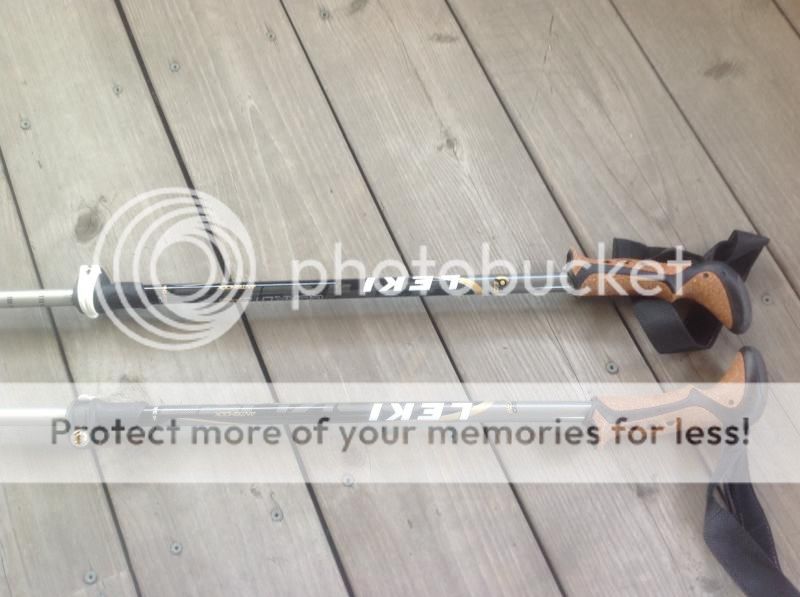
Also, the top of 1 of my poles has a camera adapter to turn the pole into a "monopod" for photography.

And then again here with the screw installed (which you leave attached to the bottom of your camera ... the camera mount installs with a simple twist of that red dial ... you only have it attached when you have the camera mounted onto the pole top.)
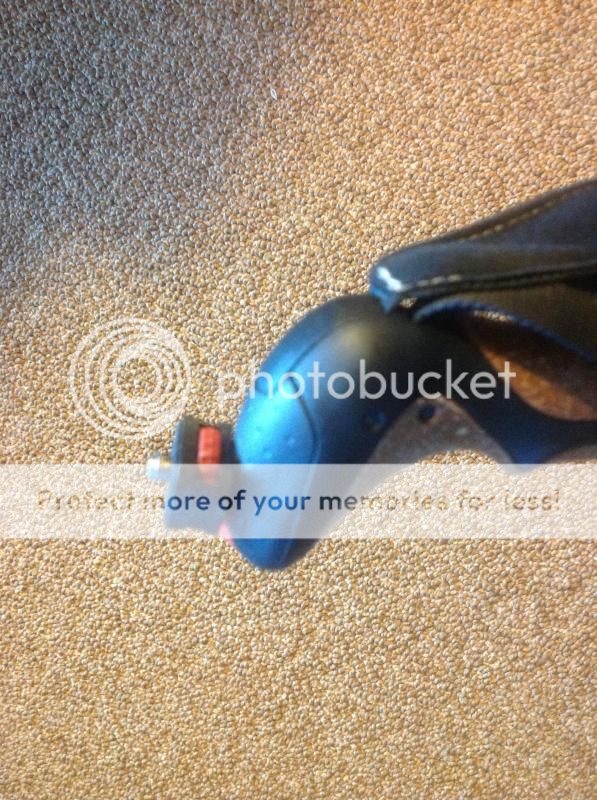
Another nice feature is the quick lock with measurement system. This allows you to stow your poles quickly, but the indicator marks allow you to return them to the SAME position for walking each time you use them. It is important to properly size your poles to your height!
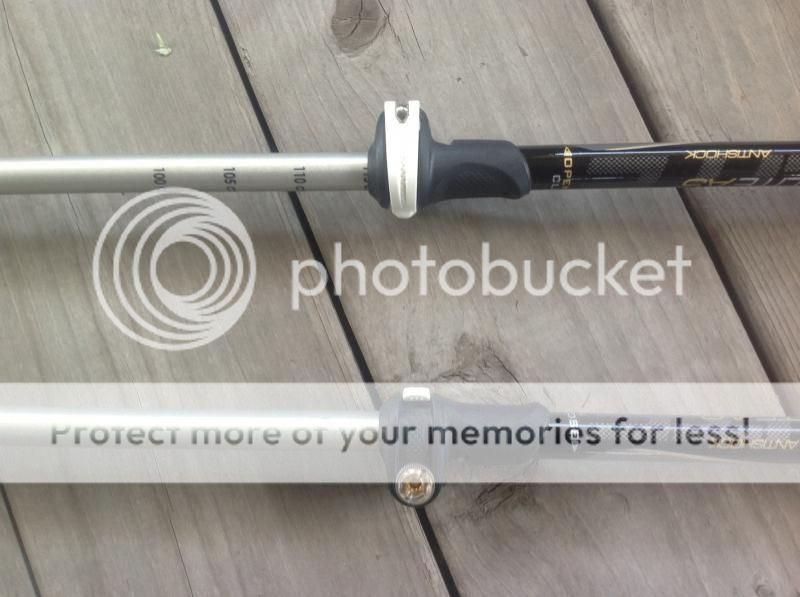
On my set of poles the Anti-Shock system is at the lower lock point and uses a stronger Cam-Lock design. While many people dislike the twisting Cam-Locks, they are in fact, stronger than the Quick Release style locks that are on the upper portion of my poles. (Again on the top pole in the photo you can see the measurement marks to return them back to the proper walking size)
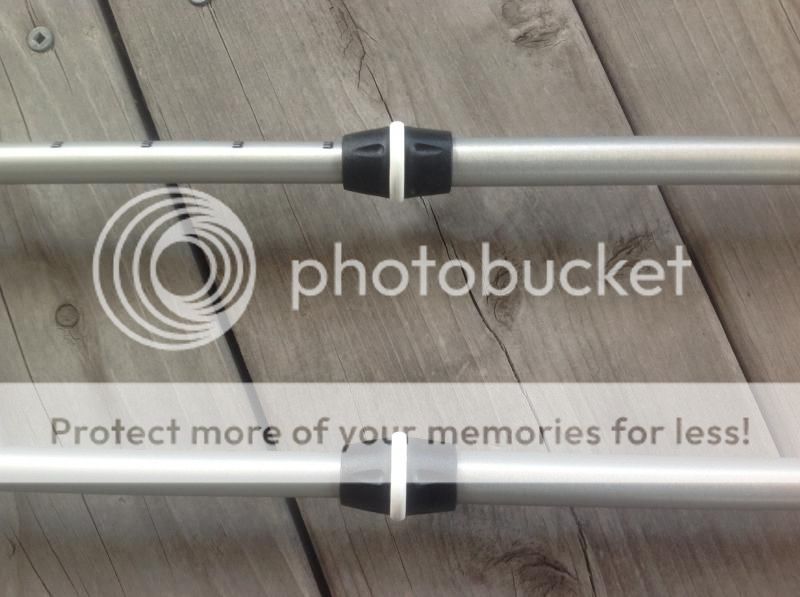
Oh, and if you DISLIKE the 'click-click-click-click' sound of the carbide tips on hard surfaces you can install various types of rubber bumpers on the tips. These are exercise tips, great for road walking. I also have a set of general purpose rounded tips. Be sure to buy high quality VULCANIZED rubber tips because the carbide tip points won't poke through them, and the asphalt roads won't wear them down quickly.
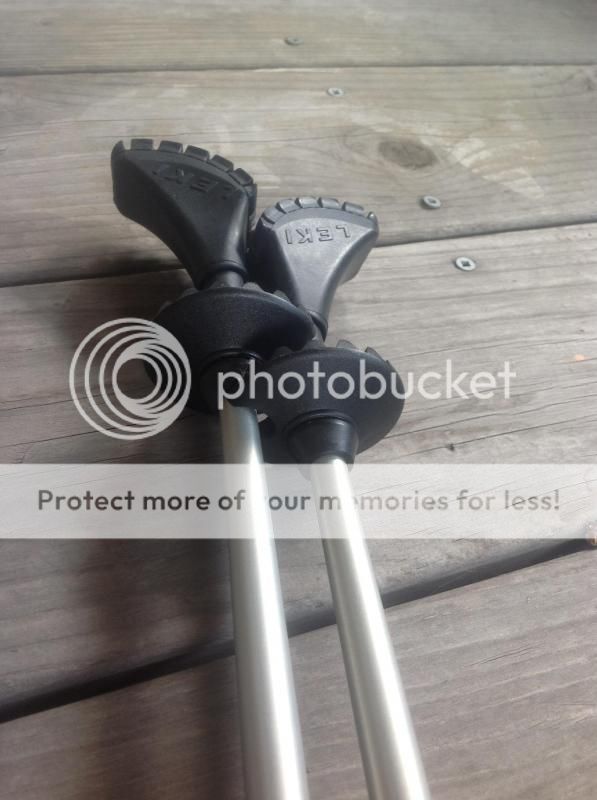
I believe there is also more benefit going downhill than uphill because I tend to put more weight on my pole plants when going DOWNHILL so the Anti-Shock gets its workout on DOWNHILL portions of a hike. ALSO, when going downhill it helps to rotate your hands up onto the tops of your poles so your palm is on the top of the pole. Some grip designs are NOT well suited for this, but most of the poles by both Komperdell and Leki are made for this.
Further when going UPHILL for extended runs it helps to SHORTEN your poles --or-- to grab just beneath the grip. Again, some poles are well suited for this. Leki brand has a quick adjust strap that allows you to, on the fly, adjust the strap so you can 1) maintain your hand in the strap AND 2) grab just beneath the grip for ascents. Komperdell has several models that have an elongated grip, just for ascent.
Other brands may offer other features but these are the 2 brands with which I am most familiar.
You can see the grips on my set of poles, they have larger rounded tops that are designed for you to put your palms on the top (while your hands are still in the straps) so you can descend slopes under greater control. ALSO, while my grips are CORK + RUBBER, many people prefer all CORK grips for greater control/grip under varied climate conditions. Rubber is not as good in the rain or in winter. ALSO, the better designed poles have grips that are angled forward, some are lightly angled (mine have a 7 degree angle to them) while others are angled as much as 30 to 45 degrees. But the cheap discount store poles are vertical with no angle at all, this can lead to hand/wrist pain.

Also, the top of 1 of my poles has a camera adapter to turn the pole into a "monopod" for photography.

And then again here with the screw installed (which you leave attached to the bottom of your camera ... the camera mount installs with a simple twist of that red dial ... you only have it attached when you have the camera mounted onto the pole top.)

Another nice feature is the quick lock with measurement system. This allows you to stow your poles quickly, but the indicator marks allow you to return them to the SAME position for walking each time you use them. It is important to properly size your poles to your height!

On my set of poles the Anti-Shock system is at the lower lock point and uses a stronger Cam-Lock design. While many people dislike the twisting Cam-Locks, they are in fact, stronger than the Quick Release style locks that are on the upper portion of my poles. (Again on the top pole in the photo you can see the measurement marks to return them back to the proper walking size)

Oh, and if you DISLIKE the 'click-click-click-click' sound of the carbide tips on hard surfaces you can install various types of rubber bumpers on the tips. These are exercise tips, great for road walking. I also have a set of general purpose rounded tips. Be sure to buy high quality VULCANIZED rubber tips because the carbide tip points won't poke through them, and the asphalt roads won't wear them down quickly.

Last edited:
Most read last week in this forum
I’m leaving soon for CP and again attempted to use what’s app without success. I was trying to call a hotel in Spain, it just rings but nothing else. A few years ago I tried using in within Spain...
I realize every ounce matters when carrying backpack and not shipping luggage ahead. However,
I know that the Spaniards are big into meat and potatoes, and not so much produce. I am thinking of...
Hola,
I gearing up to start my 1st CdS and have seen people recommended sleeping bag liners to protect against bed bugs.
Do these help or is it a myth?
Should I add the extra weight of bringing one?
So I have heard common wisdom is to bring a silk liner for your Camino (+/- a sleeping bag depending on your preference and season).
Specifically regarding silk liners, all of the ones I've...
Similar threads
❓How to ask a question
How to post a new question on the Camino Forum.
Similar threads
Most downloaded Resources
-
“All” Albergues on the Camino Frances in one pdf“All” Albergues on the Camino Frances in one pdf
- ivar
- Updated:
-
A selection of favorite albergues on the Camino FrancésFavorite Albergues along the Camino Frances
- Ton van Tilburg
- Updated:
-
Profile maps of all 34 stages of the Camino FrancesProfile maps of all 34 stages of the Camino Frances
- ivar
- Updated:














